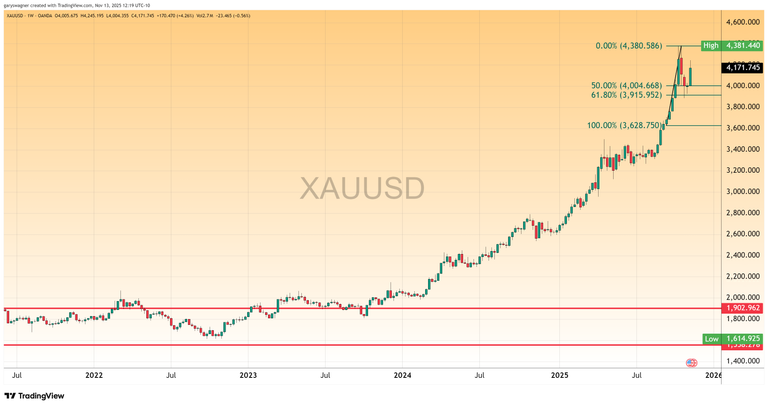Gold has shattered records in recent months, breaking through barriers that seemed insurmountable just a year ago. As someone who has watched precious metals markets for years, I can tell you this rally feels different. This is not speculative fervor or inflation panic—this is structural repositioning on a global scale.
The metal that central banks are quietly hoarding, that has served as money for five millennia, is sending a clear signal: the monetary system as we know it is entering a period of profound transition. And for those paying attention, gold's recent surge is not the end of the story—it is the opening chapter.

Understanding What We're Really Trading
When I discuss gold with fellow investors, I often encounter confusion about what exactly we are competing against. The answer is simple: we are not just betting on a metal. We are positioning ourselves outside a global monetary system built entirely on the dominance of the US dollar, and the fallacy it was built upon.
That system, for those unfamiliar with its architecture, functions like this: Nearly every international transaction flows through dollars. When Sudan sells oil to Somalia—two countries with virtually no American trade—the deal is denominated in US currency. Not because it is convenient, but because there's often no alternative. The infrastructure of global commerce, from pricing mechanisms to settlement systems, runs on dollars.
This arrangement, formalized through the petrodollar system in the 1970s, gives the United States an extraordinary advantage. Foreign nations must maintain massive dollar reserves to purchase energy and conduct international trade. This creates endless demand for US currency and Treasury securities, allowing America to print money and run deficits that would cripple any other nation.
For fifty years, this system has been unassailable. Until now.
The Cracks in the Foundation
What changed? Everything and nothing. The system has not collapsed—far from it. But the absolute certainty of dollar dominance has given way to something more tentative: calculation.
Russia's removal from SWIFT payment systems demonstrated that dollars can be weaponized. China's establishment of yuan-denominated oil contracts proved that alternatives, however nascent, can exist. Central banks from Turkey to Poland to China have accelerated gold purchases to levels not seen in decades, often conducting these acquisitions quietly, without public fanfare.
These are not the actions of nations preparing for next quarter. These are multi-decade strategic moves.
The proposed BRICS currency, alternative payment systems, bilateral trade agreements in local currencies—everyone sees these as threats to the dollar. I see them differently. They are symptoms of a deeper realization: in a multipolar world, monetary neutrality has value. And nothing is more neutral than gold.
Why This Rally Is Different
I've traded through several gold bull markets. I recall the 1970s inflation surge. The 2008 financial crisis. The 2011 parabolic rise. Each had its own character, its own drivers. This one stands apart.
Previous rallies were driven primarily by Western investors seeking inflation hedges or crisis protection. They were psychological—fear trades that reversed when confidence returned.
This rally is institutional. It's structural. And critically, it's happening while Western investment demand remains relatively subdued. The price isn't being driven by retail panic or even significant ETF inflows. It's being driven by central banks and sovereign wealth funds making strategic allocation decisions.
When gold broke through its previous all-time highs, it didn't pause, correct sharply, or show signs of speculative excess. It consolidated briefly and continued climbing. This is not the behavior of a speculative bubble. This is repricing based on fundamentally altered risk calculations.
The Marathon Mindset
Trading gold requires a different mental framework than most assets. This isn't a quarterly earnings story or a central bank policy play that resolves in months. This is a multi-year, possibly multi-decade repositioning of how the world stores value and conducts trade.
I think of it as a marathon where most participants don't even understand the distance they're running. They're sprinting in circles, exhausting themselves on short-term trades, while the real race unfolds over years.
The dollar, in this race, is the aging champion—still dominant, still powerful, but carrying injuries that accumulate with each lap. Its advantages are real: unmatched market depth, legal stability, institutional infrastructure built over decades. These don't disappear overnight.
But the dollar's competitors—the yuan, euro, BRICS alternatives—these aren't real challengers in any meaningful sense. They're incremental alternatives, constrained by their own structural problems. Capital controls, political instability, lack of liquidity—these currencies aren't positioned to replace the dollar. They're parasitic alternatives, trying to capture marginal flows without addressing the fundamental problem: counterparty risk.
The Eagle's Perspective
Here's where the metaphor becomes useful. Think of every fiat currency as a rat in a maze, scrambling for the biggest piece of cheese. The dollar is the dominant rat, the one that has controlled the maze for decades. The competing currencies—yuan, euro, proposed BRICS currency—these are fleas on the rats, feeding off the existing system while remaining trapped within it.
All fiat currencies, regardless of their issuing nation, share the same fatal weakness: they are political instruments that transfer wealth from holders to governments through inflation and debasement. The rats may fight among themselves for maze dominance, and the fleas may multiply, but they're all part of the same infestation, all subject to the same deterioration of purchasing power over time.
Gold is the eagle. It soars high above the rat race, observing from altitudes the rats cannot comprehend. Occasionally, it swoops down to feed on the very chaos that sustains the rats' competition—converting monetary instability into tangible value—then returns to the heights in seconds.
This is what we're really investing in: an asset that exists outside the fiat system entirely. No counterparty risk. No political control. No capacity to print more supply in response to government deficits.
What Recent Price Action Tells Us
Gold's breach of previous all-time highs, followed by sustained strength rather than profit-taking, tells me several things:
First, there are buyers at these levels with time horizons measured in years or decades, not months. These are not weak hands.
Second, the correlation between gold and traditional risk-off assets has weakened. Gold is rising even when stocks are strong, even when the dollar strengthens temporarily. It's behaving less like a crisis hedge and more like a strategic allocation—a permanent portfolio position rather than a trade.
Third, the lack of significant Western retail participation suggests we're still early. When mainstream investors begin allocating to gold not as a crisis play but as a monetary hedge, that's when this rally enters its mature phase.
The Path Forward
I don't pretend to know if gold hits $3,000 next month or takes two years to get there. Short-term price action is noise. What I do know is that the structural factors supporting gold—massive sovereign debt, currency debasement, geopolitical fragmentation, the weaponization of monetary systems—are not resolving. They're intensifying.
The Bretton Woods system lasted 27 years. The pure fiat dollar system has now lasted over 50. Nothing in monetary history suggests this arrangement is permanent. And every previous monetary transition has been chaotic, unpredictable, and favorable to gold.
For investors willing to think in multi-year timeframes, the question isn't whether to own gold. It's whether you own enough. The eagle hasn't just landed in breaking through previous highs—it has taken flight again toward altitudes previously unimaginable.
The rat race continues below, as it always has. The fleas multiply on their hosts, fighting for scraps. But high above, in clear air beyond the reach of monetary manipulation and political interference, the eagle soars.
In a world of rats and fleas, choose to be the eagle. The marathon has just begun, and gold is extending its lead with every passing quarter. Those who recognize this aren't speculating—they're positioning themselves for what comes next in the evolution of money itself.

